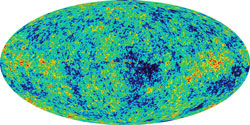Photons Are a Drag
There’s no escape from friction. Objects moving through a vacuum or even interstellar space feel a universal drag from the photons that are everywhere, according to the 28 November PRL. Although the drag is tiny, the researchers believe it may alter cosmologists’ estimates of the time it took for atoms to coalesce after the big bang. But some cosmologists say the effect, although real, is not relevant to cosmology.
Bring two pieces of metal close enough together, and they will almost always attract or repel one another, even in a vacuum, thanks to the Casimir effect. This minute force comes from virtual photons–particles of light–that continually flit in and out of existence. The effect leads to friction as one chunk of metal moves past another. Rudi Podgornik, of the University of Ljubljana, Slovenia, and his colleagues imagined taking away the second chunk, and wondered what the remaining piece of metal would experience simply moving through space.
Their calculations show that a lone object in motion experiences friction. It comes from the sea of real photons emitted by everything around it. Night vision goggles prove that any warm body emits infrared light, but even frigid intergalactic space is awash in microwave photons that would gradually slow a drifting space traveler. The friction occurs because the moving object absorbs more photons at its front surface than at its rear. The object slows from the flow of photons, just as a cyclist is slowed by the wind she feels in her face.
After establishing the mechanism, the team worked out exactly how long it would take various materials to slow down in different situations. A metal would feel a stronger drag than a nonmetal, Podgornik and his colleagues found, because metals can absorb light at all frequencies, unlike nonmetals. In intergalactic space, the slowing of a macroscopic object would only be noticeable over billions of years. In a 1000-degree-Kelvin oven, on the other hand, a water molecule would need less than five months to slow to a standstill, assuming it started out at the oven’s temperature
Co-author Wayne Saslow of Texas A&M University in College Station says the frictional effect might have slowed the motion of hot big bang debris and reduced the pace of the early clumping of matter that led to galaxies. He believes the drag increased the homogeneity of the universe and may have delayed the formation of atoms, though the effect is too small to detect with current observations.
“I thought that the paper was great fun,” says John Pendry, of Imperial College in London. “The idea that [photons] are in fact a viscous fluid is an intriguing notion.” Cosmologist Jim Peebles, of Princeton University in New Jersey is less impressed. He says the effect is real but was accounted for by cosmologists long ago. Referring to Saslow, Peebles says, “Either he or we are out to lunch.” Saslow replies that the drag he and his colleagues describe involves a photon absorption process that is different from Rayleigh scattering, the photon interaction cosmologists usually refer to. If the team’s predictions about the early Universe are correct, says cosmologist Fred Adams of the University of Michigan in Ann Arbor, “then their result would be quite important.”
–Kim Krieger
Kim Krieger is a freelance science writer in Norwalk, Connecticut.
More Information
Response to this paper: Phys. Rev. Lett. 93, 059001 (2004)





